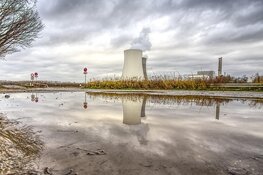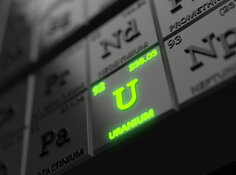The Energy Report: The uranium spot price balloon has lost air again and is back down in the mid-$30/pound (mid-$30/lb) range. It was stalled there for months last year. What pushed the spot price up in the first place? Why is it falling now?
Rob Chang: The uranium spot market is generally pretty thin, and any number of transactions on either the buy or sell side could push it in any direction. What's moved it higher recently could be the news of Japanese reactor restarts happening this summer. A couple of reactors are set to restart in the next few months or so, and we believe that helped push the price along a little bit.
But the spot price really depends on near-term utility demand. I think that's the key point here. In terms of utility demand, according to the numbers that we've seen, globally about 15–20% of uranium requirements for 2016 onward are still uncovered. Between now and the end of 2016, there needs to be some buying, either in the spot market or through some other means, to cover those requirements. We saw a bit of a lift because of that need, but certainly there hasn't been a big rush back toward buying uranium ex-spot yet.
TER: I've heard repeatedly that the deficit is going to occur in 2019 or 2020. Why aren't the mining companies moving ahead to address the deficit they know is coming?
RC: Right now, there is no incentive. For them to spend the money to do the exploration or to develop a uranium project, they need to have a price that justifies the capital that's required to get that going. Based on what I've seen, that magic number is probably in the $80/lb range for a meaningful amount of supply to come online. Currently, we're sitting in the mid-$30s/lb. To justify any project, a company would need a return of, let's say, at least 20%, but likely much, much higher. At a $35/lb, why would anyone spend the money to develop a project? That's where we're stuck.
"Fission Uranium Corp. has a world-class project; the R600W is looking quite solid and has the benefit of being on land."
Everyone knows that prices need to move higher for additional supply to come, but utilities, seeing excess inventory in the market, have been sitting back and only buying what they need when they need it. At some point this will come to a head, and prices will need to move simply because utilities will need to buy and the spot market is thin. At that point there will be a big scramble to see who can put on production quickly enough to satisfy the demand. It will be very interesting, and it's the primary reason why I believe there's going to be a violent price increase.
TER: Is the long-term price following the same trajectory?
RC: We believe it will. Currently, it has not. It's been pretty static. However, as activity in the spot market picks up, we expect to see term prices move higher as well.
TER: Japan Atomic Power Co. (JAPCO; private) and Tokyo Electric Power Co. [9501:OSE; TKECF:OTCPK]; TEPCO) both have reported selling some of their uranium stockpiles. Is that going to further deflate the price?
RC: I think that might be the reason we saw a step back in uranium prices recently. JAPCO's sale was earlier, and TEPCO's was more recent. However, I think the latter's news is a bit overblown.
TEPCO stated that it was going to reduce its inventories from current levels (17,570 tonnes of uranium/tU) to pre-Fukushima levels (16,805 tU). The 765 tU difference translates into just under 2 million pounds of uranium (2 Mlb). This figure is the potential amount of new material that may be available in the spot market, and while it is a decent amount, I would argue that it will not notably weigh on the market. A larger, 19,317 tU figure that was mentioned likely includes uranium deliveries scheduled for this year under long-term contracts. TEPCO has likely been returning this contracted material to producers for a while post-Fukushima, as evidenced by the fact that TEPCO's inventories only marginally increased from pre-Fukushima levels, yet the company has not canceled any contracts and has not consumed any uranium via operating reactors in years.
"NexGen Energy Ltd. is currently our top pick in the space due to its tremendous upside."
So TEPCO likely is not doing anything new, but instead a news agency happened to find a report within TEPCO that described this process and made it public. My belief is that TEPCO was always planning on reselling the material, as it usually does. If you look at it, a 2 Mlb increase in inventory doesn't quite make sense for a company that was getting deliveries each year for several reactors that require more than that amount to operate annually, if they are running.
TER: This sale might suggest that Japanese utilities are cutting back on their purchases. How would that affect the uranium space?
RC: Japanese utilities generally have throttled back on taking deliveries of their purchases. There have been very few, if any, outright cancellations, as far as I've heard, over the past few years since Fukushima. The companies know they don't need to take it all in, so some have been returning uranium to the producers and having the producers resell it in the market. That's why we've seen price weakness for the last three years; the producers have material that was earmarked for Japan that has come back, and they sell it through other means.
TER: The Nuclear Regulation Authority just approved restart for Japan's reactors. What will that do to the uranium price?
RC: The approval wasn't for the entire fleet. It would be great if it were. It's actually on a case-by-case basis. The recent restart approval news was for two Sendai reactors, but the agency has also given partial approval to the Takahama reactors, and to Ikata 3 as well. So restarts are moving along.
The key will be seeing some reactors actually turn on. That's going to be the first domino to fall, and we expect many dominoes to follow. But the first one is the hardest to get over the line. Once we see that, we think restarts would occur on a much more frequent basis.
TER: What effect do you expect on the uranium price from that?
RC: It's funny. On a supply-and-demand basis, it really wouldn't move the price too much because, as I said, Japan has a lot of inventory already. It's not as if the restart of just two reactors—or four or even six—is going to significantly impact the overall market.
"Given the way the whole sector has been beaten up, I think the entire space is a bargain."
What it does do, however, is bring back a lot more investor attention. There are some out there who still are skeptical that Japan will turn on any reactors. I believe they're wrong, but we need to see the reactors turned on before that can be proved. Seeing that Japan is actually going to start consuming uranium, rather than just deferring it or stockpiling it, is certainly a positive in that the global inventory won't just keep on growing and we'll start to see some usage out of Japan.
As we know, the spot market is really just between producers, utilities and a few market players. There isn't much investor speculation, so it's not as if a restart will cause more buying unless we start seeing investors step into the market and buy, like we saw in uranium's heyday during the mid-2000s.
TER: How will the price slump affect the companies you cover?
RC: What we're seeing now is a slight step back in some of the uranium equities that moved higher earlier this year because of the expectation of restarts and an improving supply-and-demand picture. What I do think, though, is that the downside is limited. Uranium prices really don't have much downside from here, in my opinion, simply because there isn't a large amount of supply coming out of nowhere, which was the catalyst for prices to move down before. Now, when I speak to producers and utilities alike, many expect prices to stay the same and, long term, to move a lot higher. I think the volatility is going to be on the upside.
TER: Would you consider any of the companies that you cover bargains or deadwood?
RC: Actually, given the way the whole sector has been beaten up, I think the entire space is a bargain. Some companies, depending on an investor's appetite, are more appealing. But across the board, the uranium companies that I cover are still excellent values at the price points that they're currently trading at.
TER: What companies are you particularly interested in right now?
RC: Cameco Corp. (CCO:TSX; CCJ:NYSE) is our No. 1 conversation piece, primarily because of its status in the space. It is the only uranium company that's publicly traded with a market cap over $1 billion. It dominates the Athabasca Basin, is low cost, and is ramping up its Cigar Lake mine. It recently declared commercial production, which is certainly positive. Cameco does have its tax issue, but I think we'll be a few years down the road before that issue starts to crystallize either positively or negatively. Either way, uranium prices would be higher by then and would justify an increase in the Cameco stock price.
TER: Cameco Corp. scored a coup with its long-term sale to India. Is China another possible market?
RC: China could certainly be a possible market. I'm not sure if Cameco currently has any agreements with the Chinese, because it doesn't specifically itemize whom it has deals with. But it certainly is potentially a great area to sell to, given that China is the No. 1 growth country with respect to nuclear.
But the deal with India certainly is a feather in Cameco's cap because India is the second-fastest-growing nuclear builder in the world.
"There will be increasing uranium demand from countries such as India and China."
I think the key takeaway here is the fact that countries such as India have identified Canada as the preferred place to source their uranium from. That speaks to definitely Cameco, because Cameco is the only producer in the area, but it also speaks to the quality of the projects in Canada, and to the excellent operational ability of companies—Cameco, in particular, but potentially other companies in the area. Of course, there's also the good jurisdiction in Canada, which means that the supply agreement will be safe. If I were to expand on this, China has recently noted that it is looking to still acquire more assets, and it has identified Canada, along with Kazakhstan and Australia, as key countries for its acquisitions.
TER: Interesting. Are any other of your companies selling to India and China?
RC: Not that I'm aware of. There are very few producers to begin with. Cameco is the primary one that I deal with that would sell outside of North America.
TER: Is there another Canadian company that you like?
RC: NexGen Energy Ltd. (NXE:TSX.V) is currently our top pick in the space due to its tremendous upside. The company's Arrow discovery, located northeast and along trend of Fission Uranium's Patterson Lake South deposit, has produced several world-class intercepts—some among the best ever reported by anyone. It is still relatively early in the company's exploration progress, and it does not have a NI-43-101-compliant resource estimate yet. However, based on what has been reported to date, we estimate that Arrow has 91 Mlb already in its A2 and A3 shears combined, with significant upside potential. The mineralization starts about 100 meters below surface, is not located beneath water, and is basement-hosted, which is different from the sandstone-hosted Cigar Lake and, as such, is not likely to have the same issues. Based on our resource estimate, NexGen is trading at a significant discount to its peers.
Other companies of interest in Canada include Fission Uranium Corp. (FCU:TSX). Fission has a world-class project, Patterson Lake South, which has 105 Mlb of resource already and clear visibility on much more. It has a Western zone, the R600W, which is looking quite solid and has the benefit of being on land, whereas most of Fission's deposit is located under water. That's important because it's going to be easier to permit. It's going to be cheaper to develop. It makes things a lot easier from the standpoint of, for example, a development scenario that includes starting from the R600W and moving east to the high-grade Triple R deposits. Fission is an excellent story that people should certainly take a look at.
TER: Aside from some of the best real estate in the Athabasca Basin, what does Fission Uranium have going for it?
RC: Fission's management has done quite well, with Chairman and CEO Dev Randhawa and President and COO Ross McElroy at the helm. They have done it once before, in terms of defining a deposit, growing, and then selling it. They've done even better with what they have now with Patterson Lake South, and what is clearly a world-class deposit. Fission has a strong team; they've done a good job.
"At a $35/lb, why would anyone spend the money to develop a project?"
One of the key things I've noticed is that Fission drills on water at an angle, which is a pretty difficult thing to do. Angle drilling, as many people know, is an important aspect of drilling a deposit because it provides much better information on the geometry of the deposit. Being able to drill at an angle is certainly positive, and it's much more difficult to do so on water with barges than it is on stable land.
TER: Is there another story in the Athabasca Basin you'd like to discuss?
RC: Denison Mines Corp. (DML:TSX; DNN:NYSE.MKT) is a very interesting story, given that the company holds a very sizable and notable position in the Athabasca Basin for nonproducing assets. Along with Fission and NexGen, you could argue that Denison probably has the best assets in the Athabasca Basin. The key with Denison is, its assets are on the eastern side of the basin, in close proximity to the infrastructure that's been built up on that side because that's where all the producing mines are currently located.
Denison also owns a part of the McClean Lake mill and is getting cash flow from the Cigar Lake feed that's going through the mill now. That's certainly positive. But it also has some excellent projects. The Wheeler River property and its Phoenix and Gryphon deposits are world-class on their own—among the highest grades of any deposit on the planet. The news flow coming from that particular property has been very exciting. We expect to see more good news from Denison as well.
TER: Denison Mines was going to report on its winter drilling program. Was that report satisfactory?
RC: It did excellent work. The world-class Wheeler River property had some excellent results. The company doesn't tend to release many drill results, but the results that it did come out with for this batch were certainly positive, world-class intercepts, long and high-grade, so certainly moving things in the right direction.
TER: What's the goal of its summer program?
RC: Denison's summer drilling program will focus on Wheeler River, Bell Lake, Murphy Lake, Jasper Lake, Stevenson River, Crawford Lake and Bachman Lake. Of course Wheeler River will be the focus, and the big item of interest for us will be the work done on the Gryphon zone, which should support the preparation of an initial resource estimate.
TER: Are there other companies you'd like to mention?
RC: Another company that makes a lot of sense is Uranium Participation Corp. (U:TSX). We like that name primarily because it's undervalued. It currently trades at a 5–9% discount to its net asset value (NAV). The fact that the company is currently trading below its NAV makes it a good value for anyone who expects or believes uranium prices will move higher.
You also have the benefit of not being exposed to company-specific risks or even country-specific risks, and that's certainly positive. For anyone who is worried about a potential mine issue, they won't have that problem with Uranium Participation. In fact, whenever there is any issue with anyone's mine, Uranium Participation would move higher simply because there's potentially less supply coming out. The value of uranium should move higher in those situations.
"We've seen price weakness for the last three years because producers have material that was earmarked for Japan that has come back."
Uranium Energy Corp. (UEC:NYSE.MKT) is another interesting story. It's an in-situ recovery producer located in Texas, and it has an excellent management team, with company president and CEO Amir Adnani appearing quite prevalently in the media talking about the uranium secctor. He is a very good champion for the space. He gets good visibility.
On top of that, Uranium Energy has the benefit of being the only entirely unhedged producer. With the expectation of uranium prices moving higher, Uranium Energy will be arguably the best positioned to fully capitalize on and realize the increases in uranium prices, because companies such as Cameco—and pretty much everyone else—have contracts. These contracts are helping companies out right now because they are higher than current spot pricing. But when prices do go up, they will eventually rise above these contract prices. Companies like Uranium Energy, which are entirely unhedged, will really stand to benefit then.
Ur-Energy Inc. (URG:NYSE.MKT; URE:TSX) is also one of our top picks in the space. We like Ur-Energy because its Lost Creek deposit has been outperforming for some time now. Since it started about a year and a half ago, the deposit has produced at a higher flow rate, so it produces uranium at a lower cost than expected. The company generally produces on the low end of the cost curve—among the lowest of any producer. Ur-Energy is among the top companies on our list due to its low cost profile.
TER: What was the conclusion of the preliminary economic assessment (PEA) published in January for Ur-Energy on the Shirley Basin uranium project?
RC: It's positive. The PEA produced an internal rate of return of 117%, and a before-tax NPV of US$215.9M. The PEA estimates production costs of US$14.54/lb., which is incredibly low. Even if we adjust for conservatism, the numbers remain pretty compelling. Shirley Basin is one of the strong growth aspects of Ur-Energy, and we expect it to be the next project that gets developed, alongside the current Lost Creek project. We're excited to see the company move forward on that one.
TER: How should investors approach the uranium space going forward?
RC: The way I look at it generally is in terms of upside versus downside. From what I see in the uranium market, there is limited downside. I do not see a catalyst that would push prices significantly downward, say into the $20/lb range. But I see many opportunities for uranium to move higher. Uranium moved significantly down before because Japanese utilities were sending material back into the market, and that material had to be resold. On top of that, some uranium companies were in slightly distressed situations and were selling uranium because they needed to raise capital to maintain operations. Right now, we're not seeing that as much.
"The time is right for uranium investing because we see the volatility on the upside rather than on the downside."
On the flip side, we're seeing 15–20% uncovered requirements beginning in 2016, and we're seeing uncovered requirements continuing to grow as the years go out from 2017 and onward. We need to see some uranium buying to shore those requirements up at the very least.
On top of that, based on our forecasts for uranium production and global reactor growth, including reactor shutdowns, there is an unavoidable supply deficit in 2020, no matter what happens. Layer on the fact that, because of the low uranium price environment, there has been very little exploration and there are only a handful of identified large-scale projects in the world. You have the Fissions, the Denisons, the upcoming NexGen Energy, and those are pretty much the only companies with potential development at a meaningful scale in the next eight to 10 years.
And there will be increasing demand from countries such as India and China. Even if all the uranium projects around the world were put on a path to production as quickly as possible, you're looking at 2023–2025 before those projects get online. But the deficit kicks into gear in 2020.
These are pretty compelling reasons for uranium prices to move higher sometime within the next year or two. On top of that, for more event-driven investors, there is the fact that the Japanese Sendai reactors are expected to turn on in the next couple of months—the operator is hoping for July, we're thinking it's probably August/September. It'll be a front-page news item when those reactors turn on. There will be a big rush into the space on that news. We think the time is right for uranium investing because we see the volatility on the upside rather than on the downside. We expect a violent increase in the price of uranium in the near future.
TER: Rob, thank you very much for your comments.
Cantor Fitzgerald Canada's Senior Analyst and Head of Metals and Mining Rob Chang has covered the metals and mining space for over eight years for the sellside and the buyside. Prior to Cantor, Chang served on the equity research teams at Versant Partners, Octagon Capital and BMO Capital Markets. His buyside experience includes managing $3 billion in assets as a director of research/portfolio manager at Middlefield Capital, where his primary resource portfolio outperformed its direct peer and benchmark by over 28% and 18%, respectively. He was also on a five-person multistrategy hedge fund team, where he specialized in equity and derivative investments. He completed his master's degree in business administration at the University of Toronto's Rotman School of Management.
Read what other experts are saying about:
Want to read more Energy Report interviews like this? Sign up for our free e-newsletter, and you'll learn when new articles have been published. To see a list of recent interviews with industry analysts and commentators, visit our Interviews page.
DISCLOSURE:
1) Tom Armistead conducted this interview for Streetwise Reports LLC, publisher of The Gold Report, The Energy Report, and The Life Sciences Report, and provides services to Streetwise Reports as an independent contractor. He owns, or his family owns, shares of the following companies mentioned in this interview: None.
2) The following companies mentioned in the interview are sponsors of Streetwise Reports: Fission Uranium Corp., NexGen Energy Ltd. The companies mentioned in this interview were not involved in any aspect of the interview preparation or post-interview editing so the expert could speak independently about the sector. Streetwise Reports does not accept stock in exchange for its services.
3) Rob Chang: I own, or my family owns, shares of the following companies mentioned in this interview: Fission Uranium Corp, Denison Mines Corp. I personally am, or my family is, paid by the following companies mentioned in this interview: None. My company has a financial relationship with the following companies mentioned in this interview: Fission Uranium Corp., NexGen Energy Ltd. I was not paid by Streetwise Reports for participating in this interview. Comments and opinions expressed are my own comments and opinions. I determined and had final say over which companies would be included in the interview based on my research, understanding of the sector and interview theme. I had the opportunity to review the interview for accuracy as of the date of the interview and am responsible for the content of the interview.
4) Interviews are edited for clarity. Streetwise Reports does not make editorial comments or change experts' statements without their consent.
5) The interview does not constitute investment advice. Each reader is encouraged to consult with his or her individual financial professional and any action a reader takes as a result of information presented here is his or her own responsibility. By opening this page, each reader accepts and agrees to Streetwise Reports' terms of use and full legal disclaimer.
6) From time to time, Streetwise Reports LLC and its directors, officers, employees or members of their families, as well as persons interviewed for articles and interviews on the site, may have a long or short position in securities mentioned. Directors, officers, employees or members of their families are prohibited from making purchases and/or sales of those securities in the open market or otherwise during the up-to-four-week interval from the time of the interview until after it publishes.











































